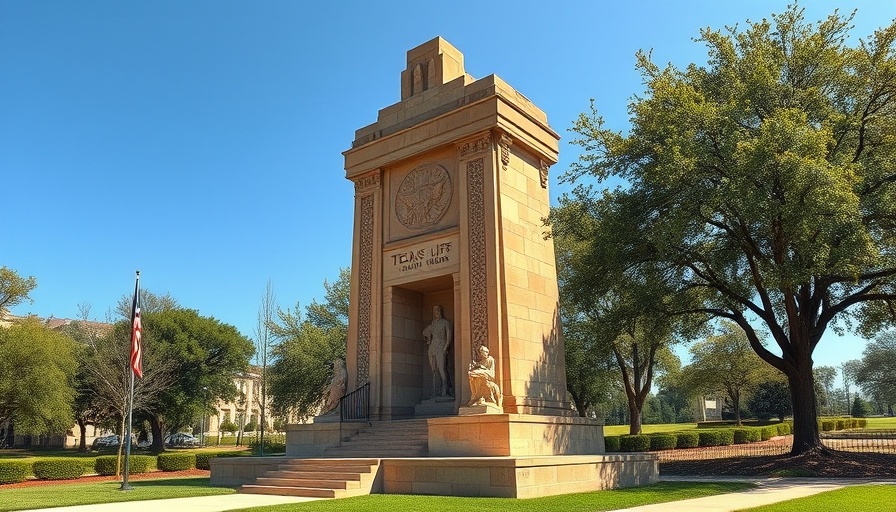
Texas Moves to Honor Motherhood with a New Memorial
The Texas Legislature has taken a significant step by approving the construction of the Texas Life Monument on the grounds of the state Capitol. This monument is designed to replicate the esteemed National Life Monument in Rome, showcasing a pregnant woman, and is expected to serve as a symbol of the beauty of motherhood.
House Resolution 19, which passed in a 98-44 vote, was spearheaded by Senator Tan Parker (R-Flower Mound) and reflects the state's ongoing discussion about maternal health versus abortion legislation. Caroline Harris Davila (R-Round Rock) emphasized that the monument will provide Texans with “a public space to reflect on the beauty and sanctity of the love of a mother for her child.” The monument is positioned as a peaceful spot for families to celebrate motherhood's strength without depicting any sexualized elements associated with female anatomy.
The Intersection of Art and Politics
The approval of the Texas Life Monument coincides with the upcoming debate on the “Life of the Mother Act,” aiming to clarify when abortion can be legally performed in Texas to safeguard a woman's life. The act intends to define a medical emergency and will allow doctors to remove fetal remains following a miscarriage, addressing some essential healthcare needs. Nevertheless, there are critics who underscore that it inadequately protects women's health, a sentiment rooted in Texas's controversial history post-Roe v. Wade.
The backdrop of this legislative push reflects a sensitive and contentious political landscape where maternal health issues are entwined with abortion rights. Following the state's stringent abortion laws after the Supreme Court's decision to overturn Roe in 2022, advocates express concerns that the Life of the Mother Act still doesn't go far enough. Recent data states that at least three women have died in Texas after being denied necessary medical care under the current abortion restrictions, raising urgent questions about maternal safety.
Public Sentiment and Community Reaction
As legislation unfolds, public sentiment plays a crucial role in shaping the discourse. Many Texans are looking for ways to engage with these evolving narratives around motherhood and reproductive rights. The idea of a monument, many argue, should not occur in isolation but rather inspire deeper conversations about holistic maternal care and support systems for mothers.
Motherhood often represents resilience and hope, but the challenges many women face resonate with fear and uncertainty, especially when navigating the healthcare system in Texas. The visible representation of motherhood through the monument could encourage families to honor and support women better, fostering a culture of empathy and kinship.
The Role of Private Funding in Public Art
Another prominent aspect of the Texas Life Monument is that it will be funded entirely through private donations. This enables a layer of freedom from political maneuvering or taxation debates that often intertwine with public funding for state projects. Private backing not only allows the monument to be a celebration of motherhood but also enables communities to come together in support of such initiatives.
However, this raises questions regarding accessibility. Will this model limit the potential public dialogue around such critical health issues? Some argue that public funding is vital for projects that speak to communal, historical, and cultural values. Therefore, balancing private and public interests in projects like this monument deserves meaningful discussions.
What Lies Ahead for Texas Legislation?
As the life monument and the Life of the Mother Act take center stage in Texas legislature, the potential implications on women’s health rights remain precarious. These discussions are critical not only for the political landscape but also for gauging how mothers and families will navigate these changes moving forward.
While the monument symbolizes strength and motherhood, it also emphasizes a collective need to reflect on how laws shape women's lives. Observers will be keen to follow the upcoming vote on the Life of the Mother Act and see how it may alter matters of maternal healthcare in the state.
Conclusion: The Bigger Picture
The construction of the Texas Life Monument represents a multifaceted narrative encompassing motherhood, reproductive rights, and healthcare inequities. There’s a need for ongoing discussions about the balance of maternal health and autonomy within the legislative framework. Texans are invited to engage actively with both the physical symbol of motherhood and the legislative processes that define and protect it.
In order to continue understanding how these laws affect our communities, it is crucial to stay informed. Consider supporting independent journalism that highlights such pivotal issues in Texas.
 Add Element
Add Element  Add Row
Add Row 



Write A Comment